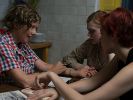Eye For Film >> Movies >> 20th Century Women (2016) Film Review
20th Century Women
Reviewed by: Anne-Katrin Titze

Mike Mills made a film of grand abundance. How can one year - 1979 - and one place - sleepy sunny Santa Barbara, California - accomplish what is promised by the title? 20th Century Women shoots an arrow into my nostalgia. It triggers the silvery longing, a ghostly dreamlike presence of the dead.
Are the most personally treasured pictures always about memory? Some of the best films this year definitely rely mightily on autobiographical reconstructions. The first chapter of Kleber Mendonça Filho's Aquarius, starring Sônia Braga, pays homage to a very specific childhood remembrance. Mia Hansen-Løve's Things To Come with Isabelle Huppert, is inspired by the director's mother. Maren Ade's Toni Erdmann, portrayed by Peter Simonischek, is a kind of celebration of the filmmaker's father.

A shimmer of Freud's concept of Family Romance sneaks into the cinema this way. These parents can replace our parents for a while and if we are lucky, tell us something about ourselves.
Annette Bening gives a glorious, all-encompassing performance as Dorothea, a woman born in 1924 who wanted to be a pilot, finds inspiration in Humphrey Bogart, is deeply moved by President Jimmy Carter's "Crisis in Confidence" speech, and raises her teenage son Jamie (Lucas Jade Zumann) mainly on her own.
Mainly, because Dorothea enlists two young women to help her educate her child into a good man. Julie, Jamie's best friend and not-so-secret crush (Elle Fanning, radiant in one of her most layered performances) is a girl from the neighborhood. Her mother (Alison Elliott) is a therapist and had the girl sit in on group therapy sessions while growing up. Julie tries to figure out who she wants to be, acts tougher than she feels, and often sneaks into Jamie's window at night to feel the safety of their friendship.
Punk artist Abbie (Greta Gerwig) is an official boarder in Dorothea's sprawling house from 1905 that is perpetually renovated by handyman and lodger William (Billy Crudup mastering an extremely complex role). He is the only defining male presence.
The house itself, with the bright yellow kitchen and crumbling stuccoed ceilings, a place where Pippi Longstocking could feel at home, matches its inhabitants. Cinematographer Sean Porter and the production design by Chris Jones create a world that is as vivid as sunshine and a melancholy mood as fleeting as a dream of a loved one's return. Jennifer Johnson's costume design targets specific choices and preferences that living breathing people make - be it a beloved silver bracelet or the hue of dress.
This is not Hiroshima, Mon Amour, and yet Mills uses a structure that resembles the freedom as well as the confines of allowing us to leap backward and forward in time with the people encountered. Images tumble like an avalanche and off-camera voices sum up what cannot be summed up.
Jamie tries to define and explain his mother (to himself and to us) as the woman who grew up during the Depression when "everybody raised their kids together." She chain-smokes, takes note of her stocks every day with breakfast, carves wooden rabbits because of Richard Adams's Watership Down and "wears Birkenstocks because they're contemporary" - oh, the eternal return of footwear!
Bening smiles an incomparable smile and transcends all of these attempts to contain Dorothea with ease and grace and mischievousness. She tells the cat that it can relax now, when her son comes home late at night and she secretly waited up for him. Julie is good at hiding, her mother calls it "compartmentalising," and she gladly joins the lively discussions of the readings Abbie suggests for Jamie. "Here's some books from my feminism class. I thought they might be good for you."
Abbie dresses as though she were painting herself into the world. One day it's green tights, purple shorts, home-dyed red hair, the next it's a Lou Reed T-shirt with holes. One of her artworks consists of taking a picture of everything that happens to her in one day, in another one, she takes polaroids of every object she owns. Her backstory includes time spent in the New York scene of the Seventies. She is also recovering from cervical cancer, caused by her mother's DES fertility medication intake.
Dialogue is as layered as everything else. "Your hair smells good." - "I make my own shampoo." - "Of course you do." Seduction is never just seduction. Classifying is never just classifying. But a kiss is still a kiss. And when Rudy Vallée croons As Time Goes By, the world is splendid, because it's still the same old story even when told by Buzzcocks, The Raincoats or Siouxsie and the Banshees.
But that would be too easy and too tightly packaged. At one point in 20th Century Women, in a very effective rupture in linear time, we are told what the characters on screen don't know yet and we don't really need to be told.
“They don’t know this is the end of punk. They don’t know that Reagan’s coming and Bush and Clinton ... It’s impossible to imagine HIV and AIDS, and the personal computer, what will happen with skateboard tricks, your own life, the internet.”
Mills chose to accompany this off-camera reading with a clip from Godfrey Reggio's Koyaanisqatsi from 1982. I remembered my conversation with Reggio about his film The Visitors and thought with a painful pang of what I miss very much about the 20th century: looking at the expressions of people in thought while they are looking within themselves and not down at a screen.
Reviewed on: 16 Dec 2016
















